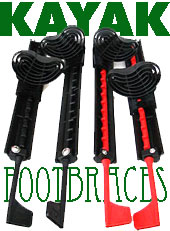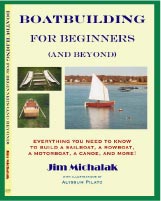|
A couple of years ago, in the summer of 2007, my wife, Helen,
and I built two baidarkas under the direction of Corey Freedman
of The Skin Boat School www.skinboats.org
in Anacortes WA.
|
Helen and the two baidarkas |
I had been a student that spring in the Traditional Small Craft
course at the Northwest School of Wooden Boatbuilding in Port
Hadlock WA https://www.nwboatschool.org/
and had helped to loft and build one of two 12-foot
lapstrake Grandy boats, plank and complete the interior of a Herreshoff
12 ½, and loft and build a 19-foot lapstrake Whitehall.
These boats, beautiful in their own right, were built in the traditional
manner starting with their keels and planked while upside down,
then turned right side up, framed and completed.
During the Small Craft course, Corey visited the School to give
us a lecture on the Aleut baidarka and what is known of their
history. Corey is widely known as an expert in their history and
construction – he’s really a walking baidarka encyclopedia,
if you can imagine such a person - since he and his many students
around the Puget Sound have built over two thousand of these indigenous
craft.
The Aleut People live along the southern coast of Alaska and
are the people for whom the Aleutian Islands are named. They live
on one of the most rugged coasts in the world, along the shore
of one of the roughest, most inhospitable seas on the planet.
“The Aleuts”, Howard Chapelle tells us in The
Bark Canoes and Skin Boats of North America, “are
daring and accomplished kayakers, and their craft are among the
finest in the Arctic”. Even among the Aleuts the type of
boat used tended to vary with the location in which it was used,
and there were doubtless many minor variations now lost to study.
Chapelle goes on to say that “Exceptional seaworthiness
is required, as most Arctic waters are subject to violent storms;
the Arctic skin boats have been developed with forms and proportions
to meet this condition. In this matter, the light and flexible
hull structure gives a special advantage. The kayak, in its highest
state of evolution and in skillful hands is perhaps the most seaworthy
of all primitive small craft.”
(The word “primitive”, though certainly meant descriptively,
grates a bit on my ears nearly 50 years after these words were
published by a man many consider to have been the Dean of American
maritime history. The baidarka, as with many other small craft
around the world, was developed by people skilled in using the
materials they had available to admirably meet the conditions
in which the boat had to be used. It can be called “primitive”,
in my opinion, only in the sense that it was not developed by
moderns).
While the origins of the unique Aleut craft, the baidarka, are
lost in the mists of time, it was the Russian explorers and traders
in the early 1600’s who called the boat by the name we use
now – “baidarka”, or “little boat”.
Russian and then European explorers who visited this part of the
world observed and recorded the little boats and how they were
used by the Aleuts and other coastal peoples. The Russians, in
particular, recognized the extraordinary seaworthiness of the
craft, and used it extensively in their harsh exploitation of
the native peoples and the fur trade.
The baidarka was the sea-going equivalent of a sports car –
fast, maneuverable, and admirably suited to hunting in rough conditions.
The umiak, in contrast, was the equivalent of a dump truck or
utility pickup truck – capacious, much slower, but suited
to carrying a great many people or tons of cargo (though smaller
versions were used for whale hunting).
Corey told us that native baidarkas were built of driftwood gathered
along the beaches, and covered with sealskin or sea lion skins.
The Aleuts, as did many of the other native peoples, designed
and made specialized garments that covered the paddler and attached
to the baidarka, helping to make man and boat into one sea creature,
and thus helping to ensure their survival in one of the roughest
seas in the world. (Such clothes, and the equipment used by the
hunter in the baidarka, are another fascinating field of study).
Aleut baidarkas are generally classified by their number of “holes”,
or cockpits – one, two or three holers. It wasn’t
unusual, the explorers tell us, to find children riding in the
bigger baidarkas under the skin covering and between the cockpits.
The smaller boats generally ran from 16 to 19 feet long, and were
often about 20 inches wide at their widest point.
These craft were also noteworthy for their bifid, or bifurcated
bow, which is useful both to extend the length of the craft (thus
making it faster for a given human horsepower) and to provide
just enough built-in flotation to help the bow rise to the seas.
Although the bifid bow was not unique to the Aleuts, they did
develop their own specialized design suited to the waters in which
they lived and hunted, and that’s generally the design Corey
has adopted.
The Russians are believed to have demanded the introduction of
the so-called three holer to support their fur expeditions. It
was reportedly was not known before their exploitation of the
Arctic. Such boats have been measured in excess of 24 feet long.
I was hooked when Corey demonstrated several of his slender 20-pound
baidarkas and illustrated their inherent strength by nimbly stepping
up on a boat’s fabric-covered foredeck while the boat was
on the floor.
Corey’s shop is a few miles south of the industrial town
of Anacortes, generally considered to be the US gateway to the
San Juan Islands from the east side of the north Puget Sound.
(This entire watery area, from the southern Puget Sound to the
north end of Canada’s Vancouver Island, has recently been
formally named the Salish (long “a”) Sea).
His shop is a spacious open tent made of wooden poles and rafters
covered with urethane fabric – essentially the same material
he uses in his boats. It is down a quiet dirt road off the side
of the main road into town, around the corner from the entrance
to his property and backs up to a quiet little pond enjoyed by
his ducks – an altogether perfectly appropriate spot for
building boats.
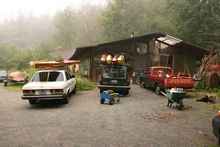 |
Corey Freedman’s shop |
We began our two week intensive baidarka-building course by heading
down to the beach a few miles away and trying out a variety of
baidarkas in a well-protected bay of the Puget Sound. After our
salt-water experience with the boats, Corey helped us decide how
long and wide our boats were to be and how we wanted to use them.
His boats are “tuned” to their owners just as the
Aleuts built theirs.
|
A well-protected bay in Rosario State Park –
perfect for trying out a new boat |
In summary, longer boats are faster, can carry more weight, and
consequently are more stable but somewhat more difficult to turn.
Shorter, narrower boats carry less weight, are more nimble but
are much easier to roll (or capsize). If maneuverability is important,
and in many cases it was to the Aleuts, then a relatively shorter,
narrower and thereby less stable boat enhanced maneuverability.
I chose a longer, more stable boat able to carry my weight while
my wife, Helen, chose a significantly shorter, more narrow boat.
Corey helped us to determine the size of our boats while we sat
on the fabric-covered floor of the tent by using our body measurements
to determine the optimal length and width of the boats.
Conceptually, it is easy to understand how these boats are built.
The bow and stern of the boat are fabricated first and lashed
together, then attached to what we would call the gunwales of
the boat. Next, the upper frames are mortised and pegged in place,
then the ribs or lower frames are steamed and mortised into place.
The keel and longitudinals are lashed to the ribs, and the hull
is covered with a modern synthetic fabric sewn in place. The cockpit
and seat are constructed and installed, and the nylon hull fabric
is covered with a protective urethane coating. Paddles and float
bags round out the ensemble. Simple!
In effect, a baidarka is built in almost the exact opposite manner
of the western boats I’d built that spring at the Boat School.
There are no metal fastenings used in the baidarka at all, and
the boat is lashed together with the modern and virtually indestructible
equivalent of seal gut – waxed nylon thread. Corey uses
small pegs, made from ordinary chopsticks, to pin the ribs and
frames into their mortises in the gunwales – no glue. That’s
it. To save time and make it possible for us to finish within
the two weeks we had allotted for the course, Corey and his assistant
fabricated some of the pieces of the craft ahead of time –
gunwale stock, the longitudinals, the pieces that make up the
bow and stern, the stock from which the ribs are made.
The baidarka, essentially, is a carefully constructed basket,
it’s construction method and pieces honed over centuries
of use to provide the strongest yet lightest and flexible boat
possible to accomplish the task it was used for – hunting
in the open sea.
The first step was learning the first of several simple knots
used to lash the red cedar pieces used to make up the bow and
stern assemblies. The stern was first, followed by the bow with
its unique and intriguing shape. When we were done, Corey helped
us to lash the bow and stern assemblies to the gunwales.
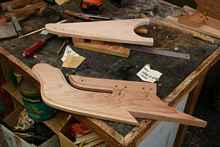 |
The bow and stern assemblies under construction.
|
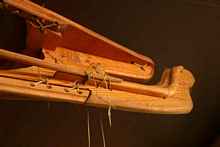 |
The completed bifurcated bow. |
Next, we fabricated the upper frames from red cedar to fit between
the gunwales and sewed them in place. Now, it looked very much
like a boat.
|
Pegging the frames. Frame end grain is soaked
in teak oil. |
Then, Corey cut the lower frames to size from the yellow cedar
(which is really a cypress, not a cedar) stock, mortised the gunwales,
and helped us to insert the frames. At this point, we added the
red cedar longitudinals (stringers) to the boat and lashed them
to the yellow cedar ribs.
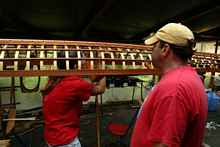 |
Lashing the yellow cedar ribs to the red cedar
longitudinals. The lashings aren’t yet trimmed in this
picture. |
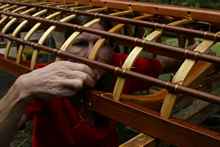 |
Working on the ribs. Corey is involved every
step of the way, but lets students proceed at their own pace. |
We constructed the cockpit using white oak soaked in hot water
and bent around a form (the Aleut used driftwood they cut to size,
soaked in boiling water and bent using their mouths and teeth).
While the cockpit was drying to shape on the form, and with Corey’s
help, we cut the nylon fabric to the size needed and sewed it
around our boats. By this time, it was abundantly clear to me
that my wife was the better skinboat builder and certainly much
faster and more efficient than I was at sewing the boat together.
|
Sewing the nylon skin together with a blind
seam. |
When the nylon fabric was sewn over the boat, we fastened the
cockpit to the boat and lashed into place.
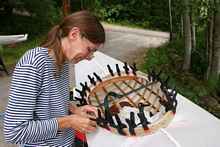 |
Adding the cockpit to the baidarka. It rests
on upper frames fore and aft, the after one of which can be
faintly seen through the white nylon fabric. |
Once the skin and cockpit construction was complete, Corey and
his assistant carefully coated it with urethane, which yielded
a reddish, virtually puncture-proof fabric covering.
Finally, we attached stretchy black nylon cord to the exterior
of the boat, which is used to secure things needed quickly by
the paddler, and a nylon line around the exterior of the cockpit,
used by some paddlers to attach their spray skirt, which in turn
keeps water from entering the boat. Since these boats are not
compartmented as are modern plastic or kevlar kayaks, float bags
are placed in the bow and stern to provide reserve flotation in
the event of an unexpected capsize.
|
The completed boats. The yellow cedar ribs are
clearly evident through the translucent nylon fabric of the
right-hand boat, while the seat boards are visible through
the cockpit of the left-hand boat. |
All together, as described, my 18 foot long 25-inch wide baidarka
is 14 inches deep at the cockpit and weighs 26 pounds, while Helen’s
boat, at 16 1/2 feet long and 22 inches wide is 11 inches deep
at the cockpit and weighs about 23 pounds.
These boats can be as much as fifty pounds lighter, empty, than
their modern counterparts, and thus far easier to handle ashore.
As a result, they can also carry as much weight as a modern kayak,
though somewhat restricted in interior volume space by the necessity
to carry the float bags bow and stern.
Getting into and out of a baidarka takes a bit more practice
than does a modern kayak. For one thing, they can’t be entered
while on the beach and slid down to the water as can a modern
kayak – despite the relatively tough nature of their urethane
coated nylon skin, it’s not impervious to the sandpaper
effect of shingle, rock or sand over time. Bairdarkas are best
entered the way the Aleuts themselves did it - while afloat in
shallow water, carefully keeping sand and beach grit out of the
boat.
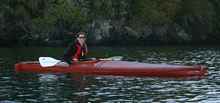 |
Paddling the Baidarka. |
The Baidarka is a superlative small craft. They excel at sea.
That unique bifurcated bow lifts easily to the swells, and the
entire boat flexes a bit as it rides over the waves, letting very
little spray slap the paddler in even moderately rough water.
The boats are easily maneuverable – no rudder needed in
the least – and the light reflected from the water shines
up through fabric of the boat, making it obvious the paddler is
riding safely in something quite unique.
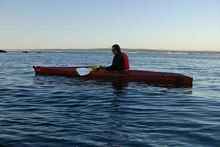 |
Out on the Puget Sound. |
If you’re interested in learning more about these unique
boats, visit Corey’s website at https://skinboats.org/
or give him a call at 360.299.0804 . I’m sure he would be
more than interested to discuss helping you to learn more about
these wonderful boats and assisting you in building one for yourself
in his well-equipped shop. Corey’s shop is The Skin Boat
School, located at 4744 Welch Lane, Anacortes WA 98221.
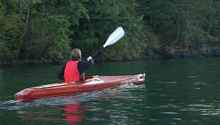 |
The baidarka is quite maneuverable. |
You can find out more about Aleutian boats in the seminal work
“The
Bark Canoes and Skin Boats of North America”
by Edwin Tappan Adney and Howard Chapelle, published in 1964 by
the Smithsonian Institution, Washington DC. I am sure there are
other books which address these unique and seaworthy small craft
as well.
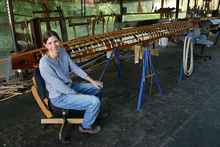 |
A very pleased first-time boatbuilder! |
*****

|

